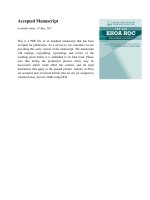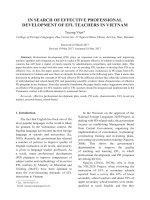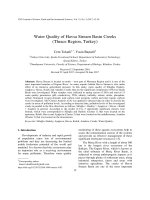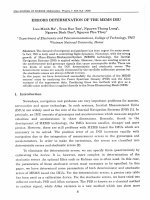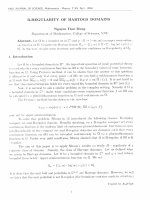DSpace at VNU: Temperature dependence of hard magnetic properties of FePd nanoparticles prepared by sonoelectrochemistry
Bạn đang xem bản rút gọn của tài liệu. Xem và tải ngay bản đầy đủ của tài liệu tại đây (880.83 KB, 6 trang )
VNU Journal of Science, Mathematics - Physics 28 (2012) 46-51
Temperature dependence of hard magnetic properties
of FePd nanoparticles prepared by sonoelectrochemistry
Nguyen Thi Thanh Van1, Truong Thanh Trung1, Nguyen Hoang Nam1,*,
Nguyen Hoang Luong1,2
1
Center for Materials Science, Department of Physics, VNU University of Science,
334 Nguyen Trai, Thanh Xuan, Hanoi, Vietnam
2
Nano and Energy Center, Vietnam National University,
334 Nguyen Trai, Thanh Xuan, Hanoi, Vietnam
Received 26 June 2012
Abstract: Hard magnetic properties of magnetic nanoparticles FePd were investigated in
dependence of temperature. Magnetic nanoparticles FePd were prepared from palladium acetate
and iron acetate by sonoelectrochemistry, an useful technique to make metallic nanoparticles using
ultrasound. Upon the annealing at 450°C to 650°C samples have ordered L10 structure and show
hard magnetic properties with high coercivity up to 2.1 kOe at room temperature and increases to
2.43 kOe with decreasing temperature down to 2 K.
1. Introduction∗
In magnetic recording applications, the higher density requires smaller the magnetic nanoparticles.
However, it is limited by the critical grain sizes due to thermal fluctuation. FePd alloy nanoparticles
with ordered structure of the type L10 have large uniaxial magnetocrystalline anisotropy of Ku ~ 1.8 ×
107 erg cm-3, which can reduce the critical grain size. This chemically stable phase of FePd
nanoparticles can be achieved by annealing at high temperature, making FePd as one of the potential
materials applicable for the ultrahigh density magnetic storage media [1-11]. In not large number of
previous studies, FePd were prepared by various methods, however the ordered L10 phase transition
varies with preparing methods [4-11]. In this work, we prepared FePd nanoparticles by
sonoelectrochemical method, which was developed to make nanoparticles [12] and successfully used
in preparation of FePt nanoparticles [13]. This method combined the advantages of sonochemistry and
electrodeposition. Upon the annealing at 450-600oC they have L10 order phase. Then, their hard
magnetic properties were investigated in dependence of temperatures.
2. Experimental
The synthesis of FePd nanoparticles was conducted by sonochemical reaction using a Sonic VCX
750 ultrasound emitter within 90 minutes and described elsewhere [12]. The mixture
_______
∗
Corresponding author: Tel.: +84913020286
Email:
46
N.T.T. Van et al. / VNU Journal of Science, Mathematics - Physics 28 (2012) 46-51
47
of palladium (II) acetate [Pd(C2H3O2)2] and iron (II) acetate [Fe(C2H3O2)2] with distilled water were
prepared in a 150 ml flask and was ultrasonicated with power of 375 W, frequency of 20 kHz. The
FePd nanoparticles were collected from the solution by using a centrifuge with alcohol at 9000 rpm for
30 minutes and then dried at 70oC-75oC. Collected powders then were annealed at various
temperatures from 450oC to 600oC under continuous flow of (N2 + Ar) gas at heating rate of 5oC/min
for 1 h.
The annealed FePd samples at various temperatures were studied by X-ray analysis in Solid State
Physics Department, Eotvos Lorand University, Budapest, Hungary. Magnetic properties of samples
were studied by using a Vibrating Sample Magnetometer (VSM) module in Physical Property
Measurement System (PPMS, Quantum Design) Evercool II in Nano and Energy Center, Vietnam
National University, Hanoi, Vietnam.
3. Results and discussion
Fig. 1 shows the X-ray patterns of annealed FePd alloy nanoparticles at 550°C for 2 hours.
Samples show the tetragonal order phase of FePd alloy (PDF 02-1440). The diffraction peaks are
shifted to higher position with increasing annealing temperature (data not shown). These peaks are
fundamental and superlattice reflections of the L10 ordered phase of FePd. In this tetragonal
superlattice structure, Fe atoms can substitute Pd atoms if they have larger amount than Pd. From the
half-width of the diffration peaks, the particle size is calculated to 48 ± 5 nm. The lattice parameters of
the ordered phase is estimated to a = 3.868 Å and c = 3.690 Å for the sample annealed at 550°C. From
these values and the ion radius of Fe and Pd, the average ratio of Fe:Pd can be estimated as 1.47:1.
The degree of the order S can be estimated by the area ratio of the peaks (200) and (002) [14]. It
increases with increasing annealing temperature and reaches maximum of 0.6 at 550°C then decreases
when annealing temperature increases to 600°C. The low value of maximum S indicates the chemical
composition as well as the degree of the order may change from particle to particle.
(111)
20000
FePd, 550 C, 2h
PDF: 02-1440 (tetragonal)
40
50
60
70
(311)
(113)
(222)
(002)
5000
0
30
(220)
(202)
(200)
10000
(110)
Intensity (a.u.)
15000
80
90
100
110
2θ
Figure 1. X-ray patterns of FePd nanoparticles prepared by sonoelectrochemistry annealed at
550°C for 2 hours.
48
N.T.T. Van et al. / VNU Journal of Science, Mathematics - Physics 28 (2012) 46-51
Magnetic properties of the annealed samples were investigated in dependence of annealing
temperature. At room temperature, annealed samples show hard ferromagnetic properties as shown in
hysteresis curves in Fig. 2. As can be seen in this figure, sample annealed at 450°C have smallest
coercivity HC. The coercivity increases when increasing annealing temperature and has maximum
value of 2.1 kOe at annealing temperature of 550°C. The coercivity then decreases when annealing
temperature increases to 600°C. At magnetic field of 1.35 T, magnetization is almost saturated and
continuously decreases when increasing annealing temperature. From these results, it can be
recognized that sample annealed at 550°C has largest (BH)max as well as largest coercivity HC. The
hard magnetic properties of annealed sample were then studied in dependence of reduced temperature
from room temperature down to 2 K. Fig. 3 and Fig. 4 show the hysteresis curves of samples at
various annealing temperature measured at 50 K and 2 K, respectively. At all the measured
temperatures, the coercivity shows similar behavior as at room temperature, which have maximum
value at annealing temperature of 550°C. The saturated magnetization at 1.35 T also decreases when
increasing annealing temperature. Fig. 5 shows the full range temperature dependence of the
coercivity HC at various annealing temperature. The coercivity monotonically increases when
decreasing temperature at all annealing temperature and have the highest value of 2.43 kOe measured
at 2 K when sample annealed at 550°C. It can be clearly seen that the sample annealed at 550°C has
largest coercivity at all measured temperatures. The degree of the order S of this sample also has
highest value compared to that of samples annealed at different temperatures, indicating that the hard
magnetic properties strongly depend on the order phase of the L10 of FePd nanoparticles.
150
o
450 C
o
Magnetization (a.u.)
100
500 C
50
o
600 C 550oC
0
-50
-100
at room temperature
-150
-15000
-10000
-5000
0
5000
10000
15000
H(Oe)
Figure 2. Hysteresis curves measured at room temperature of FePd nanoparticles at various annealing
temperatures.
N.T.T. Van et al. / VNU Journal of Science, Mathematics - Physics 28 (2012) 46-51
49
150
o
450 C
o
500 C
Magnetization (a.u.)
100
50
o
600 C 550oC
0
-50
-100
at 50K
-150
-15000
-10000
-5000
0
5000
10000
15000
H(Oe)
Figure 3. Hysteresis curves measured at 50 K of FePd nanoparticles at various annealing temperatures.
150
o
450 C
o
Magnetization (a.u.)
100
500 C
50
o
600 C 550oC
0
-50
-100
at 2K
-150
-15000
-10000
-5000
0
5000
10000
15000
H(Oe)
Figure 4. Hysteresis curves measured at 2 K of FePd nanoparticles at various annealing temperatures.
50
N.T.T. Van et al. / VNU Journal of Science, Mathematics - Physics 28 (2012) 46-51
2400
2200
2000
o
550 C
1800
HC
1600
o
500 C
1400
1200
o
600 C
1000
800
o
450 C
600
0
50
100
150
200
250
300
T(K)
Figure 5. The temperature dependence of the magnetic coercivity of the FePd nanoparticles annealed
at various temperatures.
4. Conclusion
Temperature dependence of hard magnetic properties of FePd nanoparticles prepared by
sonoelectrochemistry were systematically studied and show strong dependence on annealed
temperature from 450°C to 600°C. The coercivity HC of sample annealed at 550°C shows highest
value of 2.1 kOe at room temperature. The coercivity increases when decreasing temperature down to
2 K for all sample annealed at temperature from 450°C to 600°C. The chemical order degree of sample
annealed at 550°C also shows highest value, indicating that the hard magnetic properties strongly
depend on the formation of the L10 of FePd nanoparticles.
Acknowledgment
The authors would like to thanks National Foundation for Science and Technology Development
of Vietnam – NAFOSTED (Project 103.02.72.09) for financial support. The authors are grateful
to Dr. Gubicza Jeno for his X-ray analysis and helpful discussion.
N.T.T. Van et al. / VNU Journal of Science, Mathematics - Physics 28 (2012) 46-51
51
References
[1] D. Weller, A. Moser, L. Folks, M.E. Best, W. Lee, M.F. Toney, M. Schwikert, J.U. Thiele and M.F. Doerner,
IEEE Trans. Magn. 36 (2000) 10.
[2] H. Loc Nguyen, L.E.M. Howard, S.R. Giblin, B.K. Tanner, I. Terry, A.K. Hughes, I.M. Ross, A. Serres, H.
Burckstummer and J.S.O. Evans, J. Mater. Chem. 15 (2005) 5136.
[3] A. Cebollada, R.F.C. Farrow and M.F. Toney, “Structure and magnetic properties of chemically ordered
magnetic binary alloys in thin film form”, in Magnetic Nanostructure, H.H. Nalwa, Ed., p. 93, American
Scientific, Stevention Ranch, Calif, USA 2002.
[4] K. Sato, B. Bian and Y. Hirotsu, J. Appl. Phys. 91 (2002) 8516.
[5] K. Sato, T.J. Konno and Y. Hirotsu, J. Appl. Phys. 105 (2009)
[6] K. Sato, K. Aoyagi and T.J. Konno, J. Appl. Phys. 107 (2010) 024304;
[7] Y. Hou, H. Kondoh, T. Kogure and T. Ohta, Chem. Mater. 16 (2004) 5149.
[8] Y. Hou, H. Kondoh and T. Ohta, J. Nanosci. Nanotechnol. 9 (2009) 202.
[9] K. Watanabe, H. Kura, T. Sato, Sci. Tech. Adv. Mater. 7 (2006) 145.
[10] L. Wang, Z. Fan, A.G. Roy, D.E. Laughlin, J. Appl. Phys. 95 (2004) 7483.
[11] M. Chen and D.E. Nikles, J. Appl. Phys. 91 (2002) 8477.
[12] A. Gedanken, “Novel methods (sonochemistry, microwave heating, and sonoelectrochemistry) for the preparation
of nanosized iorganic compounds,” in Inorganic Materials: Recent Advances, D. Bahadur, S. Vitta, andO.
Prakash, Eds., p.302, NarosaPublishing, Delhi, India, 2002.
[13] Nguyen Hoang Nam, Nguyen Thi Thanh Van, Nguyen Dang Phu, Tran Thi Hong, Nguyen Hoang Hai and
Nguyen Hoang Luong, J. Nanomater. 2012 (2012) 801240.
[14] B.E. Warren, X-ray diffraction, 1st ed., Massachusetts: Addison-Wesley Publishing Co., 1969.


